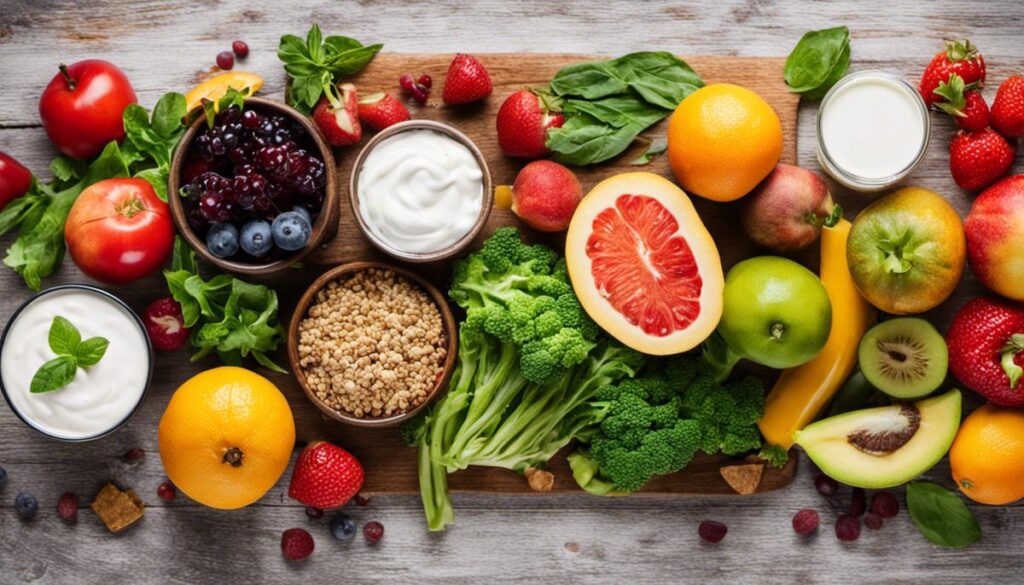Good nutrition is the foundation of a child’s growth, development, and overall well-being. Parents, educators, and caregivers hold the key to instilling healthy eating habits and a robust relationship with food that can last a lifetime. When nutritious foods become part of a routine, children are more likely to develop an understanding of the critical role that a balanced diet plays in their general good health.
This guides mapping out a balanced diet suitable for youth, stressing the significance of healthy eating habits, creating strategies for picky eating, and providing delicious, healthy recipes.
Additionally, we discuss how to nurture lifelong healthy eating habits in children, empowering them to make informed decisions about their own nutrition as they grow.
Understanding Healthy Eating for Kids
Healthy Eating for Kids: Unraveling the Real Picture
Are you diligently trying to crack the code to healthy eating for your little ones? If so, you are not alone! Most parents are on a continuous quest to understand what healthy eating for kids truly looks like. So, with the shared vision of fostering healthy habits in our children, let’s dive right into this topic.
Fruits and Vegetables: Daily Superstars of your Child’s Plate
As cliché as it sounds, the old adage ‘An apple a day keeps the doctor away’ holds truth when it comes to feeding your children. A diet rich in colorful fruits and vegetables is a treasure trove of crucial vitamins and minerals needed for a growing child. The dietary fibers present in plant-based foods support digestion and promote fullness, thus preventing overeating.
Whole Grains: The Energy Powerhouses
Whole grains like oatmeal, whole grain bread, brown rice, and quinoa offer an excellent source of energy without the sugar rush associated with refined grains. They provide essential nutrients like vitamin B, iron, and fiber. Making whole grains a regular part of your child’s diet helps them develop a taste for healthier options early in life.
Protein: The Building Blocks of Life
Don’t underestimate the power of protein! It’s an essential nutrient for growth, development, and boosting the immune system. Lean meats, fish, dairy, eggs, and plant-based proteins like tofu and legumes are splendid sources of protein.
Healthy Fats: Don’t Dodge them Completely
Believe it or not, fats are equally essential for your child’s diet. They support the brain’s development and hormone production. However, it’s necessary to offer the right types of fat – namely unsaturated fats found in avocados, nuts, seeds, and fish.
Hydration Station: Water is Wellness
Soda and packaged juices might be your child’s favorite go-to drinks, but water should be the top choice. It supports multiple bodily functions without adding any empty calories. Encourage frequent small sips throughout the day.
Portion Control: The Final Word
Remember, when feeding kids, the motto should be quality over quantity. Portion control is essential for preventing overeating and maintaining a healthy weight balance.
Raising healthy eaters isn’t an overnight success. It’s a gentle journey of cultivating nutrition awareness and fostering love for wholesome foods. It’s about helping your kids develop an appreciation for how good their bodies feel when fueled by the right nutrients. And remember, it doesn’t have to be picture-perfect every day. A little bit of indulgence and those sudden ice-cream cravings are all part of the journey. After all, balance is the key to life and of course, a healthy diet!

Importance of Healthy Eating for Kids
Healthful eating is fundamental to ensuring the well-rounded development of children. When we have already touched upon certain integral food components and mindful practices like hydration, portion control, balance, and occasional indulgence, we might want to tread deeper into the subject. Let’s help realize the motley of nutrients that are still crucial for a child’s evolving growth and health.
Ensuring a Steady Supply of Vitamins and Minerals
A child’s diet should be brimming with an array of vitamins and minerals. These essential nutrients play an enormous role in strengthening children’s immune systems, improving bone health, aiding nerve function, and ensuring overall robust growth. Foods rich in these nutrients include dairy products, leafy greens, orange-colored fruits, fish, and lean meats.
Unlocking the Potential of Fiber
A nutrient that often gets overlooked in conversations around children’s diets is fiber. It is fundamentally supportive of good digestion. Fiber reduces the chance of constipation and bolsters gut health by encouraging a beneficial environment for good bacteria. Encourage the intake of fiber-rich foods like beans, lentils, broccoli, berries, and whole grains, which we already appreciate as an incredible energy source!
Much-Needed Calcium and Vitamin D
Calcium and Vitamin D are not just essential for healthy bones but also crucial for the proper development of teeth and muscles. While dairy products are an accessible option for lactose-intolerant kids, alternatives like fortified soy milk, almond milk, or leafy greens should suffice. Vitamin D can be supplemented with fortified foods and sensible sun exposure.
Regular Iron Intake for Robust Health
Iron ensures the healthy production and function of red blood cells. Good sources include legumes, spinach, red meat, and iron-fortified cereals. An iron-rich diet coupled with Vitamin C sources such as citrus fruits can enhance iron absorption.
Balanced Meals for Sustained Energy
Meal timings matter. Regular, balanced meals, coupled with healthy snacks in between, offer sustained energy, curb junk food indulgence and normalize metabolic patterns. Also, ensure lots of colors on their plate – each color indicates a different set of nutrients.
Let’s Talk Labels
Making children a part of meal preparations, investing time in ‘label-reading’ excursions, and educating them to understand what’s good and not-so-good can result in greater health awareness.
Remember, every child is unique, and so are their dietary requirements. Consider seeking advice from a pediatric dietitian for personalized recommendations. Let’s strive to plant the seeds of healthy and conscious eating in children early, which would blossom into a lifetime of well-being and wellness. The journey of raising healthy eaters isn’t just a responsibility; it’s a joy.

Addressing Picky Eating Habits
Alright, supermoms and superdads, you’ve done some great work instilling vital knowledge about different food groups, hydration, and portion control in your kids – and let’s not forget the importance of balance and occasional treats! Now, let’s dive into some strategies for introducing new, nutrient-dense foods to our finicky little gourmands.
Let’s begin with the most awaited part – the presentation! Sure, a canvas is for artists, but a plate could be your masterpiece, too! Brightly colored vegetables, creatively shaped sandwiches or colorful smoothie bowls – get artsy with food. We want to captivate those little eyes and stimulate excitement about mealtime!
Up next – the magic of familiar favorites! Combining new and old can be a successful tactic. Imagine your child’s favorite spaghetti, but this time incorporate some finely chopped spinach or grated carrot into the sauce. Your hidden heroes are doing their job while your little one savors the familiar taste of spaghetti we all love.
One surefire way to get those intrigued taste buds working overtime is through positive peer pressure. Organize a healthy snack day where everyone brings a unique, healthy snack to share. The collective munching and positive reviews might encourage your child to try out new foods.
Don’t underestimate the benefits of getting the kids involved in the kitchen. Constructive involvement nurtures a sense of accomplishment and promotes a willingness to taste what they’ve helped create. It may take a bit of time and a whole lot of patience, but this interactive process could just be the key!
Converting a “no” to a “maybe” and, finally, a “yes” is an art, so experiment with cooking methods. Steamed broccoli might not appeal, but a quick stir-fry with a pinch of garlic may just do the trick. Roasting veggies can offer a different texture and enhanced flavor. An open-minded approach to cooking could successfully win over your little critics.
We know the nutrition clock ticks a bit differently for each child – so maintaining a variety of food options is essential. Perhaps your little one needs an extra helping of iron-rich food, or maybe they require more calcium. Having a range of wholesome choices available could potentially cater to these individual needs.
Lastly, parents, be patient and remember, every small victory counts! Today’s rejected spinach might be next month’s superfood. The goal is not just to nourish but to teach real love for a wide variety of foods – building blocks for a lifetime of healthy eating habits.
There you have it, parents! Armed with these tips, you’re ready for another adventurous trip down the road of healthy eating. Always remember, it’s not about perfection but rather progress, one veggie at a time!

Recipes for Healthy Meals
To win in the kitchen battlefield where picky eaters reign, creativity, persistence, and an arsenal of easy-to-prepare, flavorful recipes often help. Among these helpful recipes, simple smoothies are a great way to boost your child’s intake of fruit, vegetables, protein, and other essential nutrients. Mix-ins like Greek yogurt, flaxseeds, or nut butter add a protein punch and a dose of healthy fats without altering the taste. For a refreshing option, a blend of strawberries, banana, almond milk, and a spoonful of honey makes for a delicious, vitamin-packed treat.
Breakfast, as we know it, is the most important meal of the day, and the versatility of a whole-wheat pancake is hard to beat. You can fortify the pancakes by adding pureed fruit or vegetables such as apples, bananas, or even sweet potatoes. Top them off with a dollop of Greek yogurt and a drizzle of pure maple syrup for a nutritious twist that is sure to be a hit.
Fussy eaters often adore finger foods. Transform classic chicken nuggets into a nutritious meal by using whole wheat breadcrumbs for coating and baking the nuggets instead of frying them. Pair this with a homemade tomato sauce filled with hidden vegetables, and you have a dish that’s not just scrumptious but also loaded with essential nutrients.
Don’t underestimate the power of a good pasta dish. Whole grain noodles tossed with a protein source of grilled chicken or beans, plus a homemade tomato and vegetable sauce, provide a balanced, nutrient-dense meal. To make it more enticing for the kiddos, use pasta shapes they love and serve with whole wheat garlic bread on the side.
For snack time, energy balls are the perfect quick bite. Made from rolled oats, nut butter, honey, and flax seeds – plus their choice of add-ins like chocolate chips or dried fruits – these no-bake treats are both nutritious and tasty. A perfect combination that keeps kids coming back for more.
Lastly, let’s not forget about dessert. Satisfy their sweet tooth with a homemade fruit parfait. Layers of fresh fruits, natural yogurt, and granola make a dessert that’s as beautiful as it is nutritious. Let them choose their fruit and yogurt flavors, and they might forget they’re eating something healthy.
Remember, it’s all about leading with a gentle hand, not pressure. As parents, we can shape their tastes and attitudes towards food by offering a variety of nutritious choices, role modeling healthy eating, involving them in meal planning and preparation, and above all, demonstrating patience and consistent positive encouragement. The road to a balanced, nutritious diet can be exciting and full of exploration. And these simple recipes are just one delicious part of the journey. Enjoy the ride!

Instilling Lifelong Healthy Eating Habits
Guiding our beloved children towards healthy eating is a journey that demands patience, creativity, and positivity.
Certain fun and appealing food presentations can play a massive role in piquing their interest and motivating them to try new foods. But how do we ensure they are not only eating but also loving their greens and grains? Let’s look at this a bit more.
As parents, we all know the unwritten rule: If the meal looks inciting, it stands a good chance. Invoke your inner artist and add color, shape, and texture to your children’s plates. Find inspiration in their favorite cartoon characters or hobbies, and use natural colors from a variety of fruits and vegetables for appeal.
Bringing familiarity to the table alongside the new food items is another effective strategy. Inserting nutrient-dense foods into their beloved meals might do wonders. Be it a few broccoli florets added into mac and cheese or a handful of spinach into their favorite pasta; new foods blend seamlessly when mixed with their well-loved cafeteria standbys.
Creating an environment of positive ‘peer pressure’ also gives impressive results. Sibling dynamics or group meals can encourage your child to take a bite of the Brussels sprouts they wouldn’t have tried otherwise. Remember that it might take a few tries before they accept a new food group, and that’s okay. Patience is crucial in this journey.
Speaking about involvement, why not invite them into the food-making process? Children are likely to be more receptive to new foods when they’ve had an active role in preparing them. Simple tasks like washing vegetables or stirring the batter can give them a sense of ownership and boost their confidence.
Looking to add some diversity to their palate? Leave no rock unturned when finding different cooking methods to make food more appealing. Grilling, roasting, or steaming can drastically alter the texture and taste of certain foods and could prove enticing for your child.
Ensuring variety in every meal is a proven way to cater to individual nutrition needs. A colorful plate not only attracts our eyes but also provides a multitude of vitamins and nutrients.
Remember, massive strides in nutrition doesn’t happen overnight. Small victories should be celebrated, such as successfully integrating one new vegetable into their meals.
A few quick ideas to kickstart this journey could include a delightful breakfast of whole wheat pancakes accompanied by fresh fruits instead of syrup. A nutritious yet delicious chicken nugget recipe uses whole wheat breadcrumbs and whips up a homemade tomato sauce that avoids excessive salts. If your child leans more towards pasta, integrating grilled chicken or beans with a homemade tomato and vegetable sauce can pack in a healthful punch.
The overlooked savory snack, energy balls can provide a powerful yet tasty snack for your little ones. Made from granola, different nuts, and honey; they deliver a protein and fiber-rich experience. Or if your child has a sweet tooth, a homemade fruit parfait with fresh fruits, natural yogurt, and granola also promises a nutritious, delicious treat.
In the labyrinth of shaping our child’s eating habits, patience, and positive encouragement are your best companions. Each child is unique; they have individual tastes and preferences, and that’s what makes them special. As parents, guiding them gently towards healthier choices without enforcing them is likely to turn mealtime disputes into dining delights, providing them with a strong foundation for a healthy life.

Achieving effective lifelong healthy eating habits is not merely about imposing restrictions or creating stringent rules, but rather about cultivating an affirmative, lasting connection with wholesome, nutritious foods. Through a nuanced understanding of what constitutes a healthy diet for children, recognizing the vital role of nourishing eats in their overall development, handling picky eaters with patience and care, and sparking their excitement with creative, tasty recipes—you are not just feeding your kids meals but feeding their futures. We trust that this journey through the process provides you with the knowledge and tools to make this important aspect of parenting a gratifying experience capped with the satisfaction of seeing your kids grow strong, healthy, and happy.





